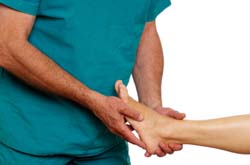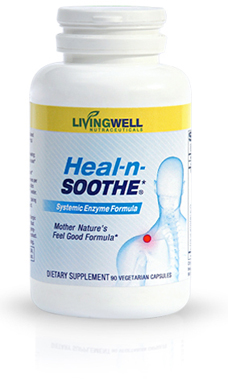
Are you experiencing big toe pain? Most likely you simply stubbed your toe or need better fitting shoes. But it can also be a sign of a deep-seated condition such as gout or a lingering injury from foot trauma.
More serious causes of pain in your big toe may include structural deformities, vascular disease or chronic inflammation of surrounding tendons and ligaments.
Sometimes the pain reaches from deep inside the joint. Other times it’s confined to the nail. Whatever the cause, big toe pain can stifle an active lifestyle.
Your feet are a complex structure of bones, tendons, ligaments, joints, and muscles. Your big toes help preserve balance and bear a great part of the burden generated by walking, running and other activities.
As a result, pain in your big toe can cause serious mobility problems. Here are some of the common causes to fight the pain and treatments for big toe pain to get you moving again.
1. Gout
Gout is a painful condition that occurs when uric acid builds up in the joints or soft tissues. The uric acid crystals lead to inflammatory arthritis that can affect your big toe, knee and ankle joints.
- Marked by crushing, throbbing, or agonizing pain
- Pain comes on suddenly, often at night
- Joints may appear swollen, tender, and red
- The attack may be accompanied by a fever
Treatment — If you are overweight, your doctor may want you to shed some pounds. He may limit your alcohol consumption as well. You should stay away from high purine foods, which can increase uric acid levels and avoid foods that increase inflammation.
2. Bunions
A bunion is a bony outgrowth that forms on the outside base of your big toe when your big toe points abnormally towards your second toe rather than forward. The condition becomes more painful as extra bone and a fluid-filled sac form at the base of your big toe.
- Bulging bump forms on the outside base of your big toe
- Inflammation develops around your big toe joint
- Thickening of the skin of your toe and corns or calluses appear
- Movement of your big toe is restricted
Treatment — Avoid high heels and tight fitting shoes. Bunion pads can be used to ease irritation and reduce pain and swelling. Toe straighteners can be worn in shoes, plus bunion splints and braces can be worn at night to push the bones back into their original position.
3. Turf Toe
Turf toe is a sprain to the ligaments at the base of your big toe. This injury typically occurs in athletes playing on grass or artificial turf. Hyperextension of the toe occurs when the big toe is forcefully jammed or bent backward, beyond its normal limits.
- Pain starts instantly due to an injury
- There may be inflammation and swelling
- You may feel a pop when the injury occurs
- Toe movement is limited and the entire joint is affected
Treatment – Immediate treatment is to control swelling and inflammation by alternating ice and heat packs. Rest up and give your injury ample time to heal. Your big toe may be taped to reduce stress, the foot put into a cast to immobilize the toe, and crutches used to support your body weight.
4. Injury or Trauma
Trauma of the foot is another common cause of big toe pain. Your toe can be broken, sprained, or fractured due to injury or overuse. Most minor fractures can be treated at home. For severe injuries, seek medical help.
- Localized pain
- Swelling and disfiguration
- Bruising can last for weeks
- Stiffness and restricted movement
Treatment — Severe injuries can take 6 to 8 weeks for complete healing. Rest the injury and apply ice. Later, try alternating ice and heat to reduce swelling and pain. Keep your foot elevated to minimize swelling.
5. Hallux Rigidus
This form of degenerative arthritis usually affects adults between the ages of 30 and 60. The condition is often related to an old high school sports injury or the lingering effects of turf toe. As this disease progresses, your big toe’s mobility decreases and the condition can become debilitating.
- Pain that can disturb your rest
- Aching pain in your lower back, hip, or knee
- Trouble wearing shoes due to bone spurs
- Limping movement when walking
Treatment — Options include custom orthotic devices to improve foot function, shoe modifications designed to put less pressure on your toe and activity modification such as low impact exercise. Far infrared heat may provide temporary pain relief.
Natural Treatment for Big Toe Pain
Never take the health of your toes and feet for granted. Delays in treatment can lead to immobility and even amputation. If you’re experiencing persistent big toe pain, have it diagnosed by a specialist to rule out serious injury and disease.
Whether you have a minor sprain or even a more serious condition, did you notice that every one of these common causes of big toe pain involve inflammation in some form? That’s why controlling inflammation is one of the most important long-term treatment options.
But don’t reach for that ibuprofen just yet. Virtually every non-steroidal anti-inflammatory drug (NSAID) carry significant health risks. So try a natural approach to easing inflammation instead.
Start by introducing more anti-inflammatory foods to your diet. Then give your body what it needs but no longer makes enough of: proteolytic systemic enzymes. These tiny pain fighters not only whisk away painful inflammation, they also eat up excess fibrin – the source of scar tissue and dangerous blood clots.
You can find the proteolytic systemic enzymes you need along with eleven more powerful, natural anti-inflammatory pain fighters (without the side effects of NSAIDs) in our all-natural Heal-n-Soothe®. And unlike over-the-counter pain meds or even prescription pain killers, Heal-n-Soothe® is guaranteed to help your big toe pain – or any other pain – or you get your money back.
Treat Big Toe Pain – Naturally
References
U.S.Department of Health and Human Services. Gout. National Library of Medicine: National Institute of Health. 2011 Jun 28.
U.S.Department of Health and Human Services. Bunions. National Library of Medicine: National Institute of Health. 2012 Feb 27.
Williams, Bruce. How to Treat Turf Toe Injuries. Podiatry Today. 2008 Sept, Vol 21(9); 38-43.
U.S.Department of Health and Human Services. Broken toe – self care. National Library of Medicine: National Institute of Health. 2012 Jun 11.
American Collegeof Footand Ankle Surgeons. Foot Health Facts: Hallus Rigidus. 2010 Mar 29.



I like how you said that there is low impact exercise that you can do in order to reduce big toe joint pain. This would be really nice because one of our kids has been complaining about this kind of pain. He plays soccer so I wonder if that has something to do with it. It’ll be good to find out what he can do to stay in shape.
Todd,
1. when the kid complains, best to give the sport a break, at least some amount of time…
2. In general, it may be a good idea to have your child’s, feet tested to see how their foot hits the ground are they overly pronated or supinated, is their foot and ankle stable?
3. One trick you can do is look at the soles of your child’s shoes all of them including the cleats and see if the wear pattern is the same, if so, go get their feel assessed.
4. Note to self: if orthotics are suggested do NOT let them put a lift in them, there are other ways to address leg length discrepancies
If you want more help or suggestions, you can contact us direct
Thanks
Steve